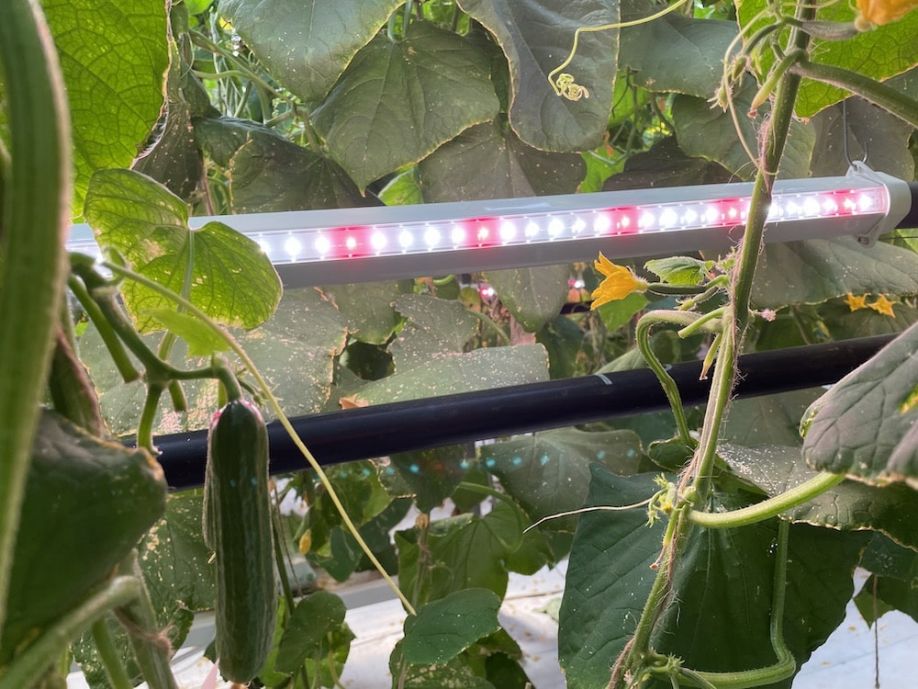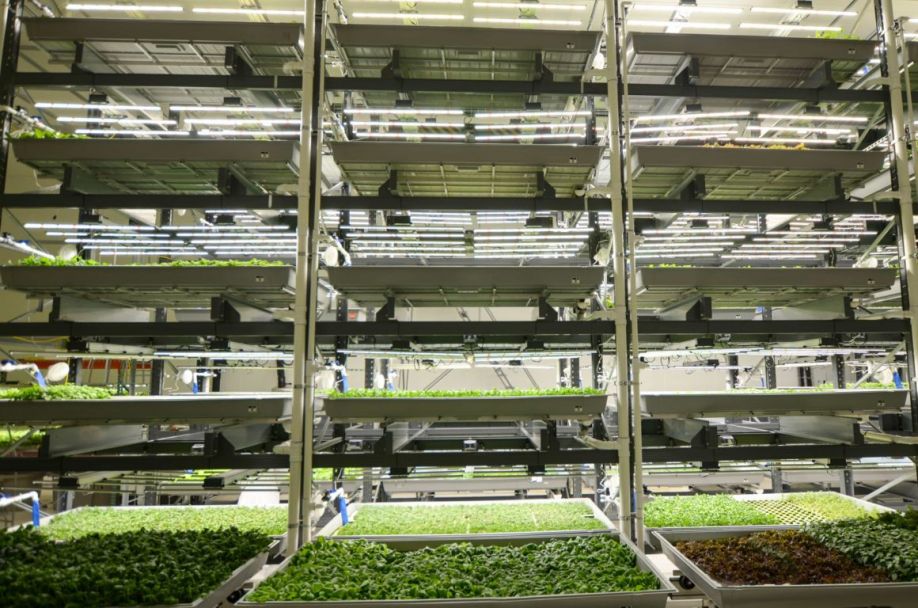Even though light is absorbed by leaves at the top of the canopy, shading from neighboring leaves reduces the light available to leaves lower in the canopy and the plant is living up to less than its full photosynthetic potential.
![How Intercanopy Lighting Can Help Your Grow]() How Intercanopy Lighting Can Help Your Grow
How Intercanopy Lighting Can Help Your Grow

Article from | FLUENCE
One of the most limiting factors in greenhouse crop production is light and seasonal variation, and limitations of light can inhibit crop productivity. In greenhouse crops, planting densities are high and can cause unwanted plant shading from plant to plant and deep into the plant canopy. Thus, there can be variation in light intensities that can reduce the physiological and biochemical process of the plant, leading to reduced yields and quality. However, for leafy greens and herbs, the effect of shading can be minimal. For vine crops like tomato and cucumber and crops like cannabis that are bushy, light intensities are significantly reduced deep within the plant canopy. Even though light is absorbed by leaves at the top of the canopy, shading from neighboring leaves reduces the light available to leaves lower in the canopy and the plant is living up to less than its full photosynthetic potential.
Intercanopy LED lighting has become an increasingly popular choice for greenhouse vegetable crop growers due to its numerous benefits. This type of lighting system is designed to be installed between the rows of plants and within the plant canopy, providing optimal illumination for crops while minimizing shadowing. Intercanopy lighting has traditionally been paired with supplemental, whether that be high-intensity discharge (HID) lights like high-pressure sodium (HPS) lamps or energy efficient LED top lights, or a combination of these lighting strategies known as a hybrid lighting system. However, there are legacy greenhouses in many parts of the world that are built too low to house top lighting and may benefit from sole source supplemental intercanopy lighting. One of the great benefits of LED lighting is that growers can place these lights closer to the plant without intense radiant light energy, such lights as HIDs, that can potentially burn the foliage of the plants if too close to the plant canopy. Thus, growers can use LEDs in places, such as the intercanopy of the crop, to increase the distribution of the light where crops can benefit the most and increase crop productivity. In this article, we will explore the benefits of intercanopy LED lighting for greenhouse vegetable crops and how it can help maximize yield and quality.
One of the most significant benefits of intercanopy LED lighting is its energy efficiency. LED lights consume less energy than traditional lighting systems, such as HID lamps. This means that greenhouse growers can save money on their energy bills while still providing their crops with the necessary light to grow and thrive. Coupling the intercanopy lighting with toplight LED or a combination of HPS lights can still have a significant impact on energy savings while distributing more light into the canopy of the greenhouse crop. In addition, the lower energy consumption of LED lights also results in lower heat emissions, which can help regulate greenhouse temperatures and reduce the need for additional cooling systems. Previous research demonstrated that LED toplight with intercanopy lighting had better energy-consumption metrics indicating that the electrical conversion efficiency into fruit biomass was 75% higher than with HPS overhead lighting.
Another benefit of intercanopy LED lighting is its ability to provide consistent light distribution throughout the greenhouse. Traditional lighting systems can cause shadowing, which can result in uneven plant growth and reduced crop yields. For example, intercanopy lighting applications has been shown to reduce intercanopy shading conditions in high-density greenhouse vine crops. Intercanopy LED lighting can, however, provide uniform light distribution, ensuring that all plants receive the same amount of light. Previous research demonstrated that intercanopy lighting in combination with top LED lighting had more uniform light absorption than either lighting arrangement by itself. However, growers need to consider the position and amount of intercanopy LED lights to maximize the light absorption within the canopy.
Intercanopy LED lighting is also highly customizable, allowing growers to adjust the light spectrum to suit the specific needs of their crops. Different crops require different levels of light intensity and quality, and intercanopy LED lighting can be adjusted to meet these requirements. This means that growers can tailor their lighting systems to promote growth and maximize yield for their greenhouse vine crop. In addition to these benefits, intercanopy LED lighting also promotes the uniform growth of crops. This means that all plants in the greenhouse receive the same amount of light, resulting in consistent growth and development. This is particularly important for vine crops that are harvested for their fruits, as uniform growth ensures that all produce is of the same quality and size. Another benefit of intercanopy LED lighting for greenhouse vegetable crops is its ability to promote photosynthesis. Photosynthesis is the process by which plants convert sunlight into energy, and it is essential for plant growth and the production of nutrients.

Intercanopy LED lighting provides the ideal light spectrum for photosynthesis, ensuring that plants can maximize their energy production and nutrient synthesis. Previous research has indicated that intercanopy lighting in cucumber plants increased photosynthetic efficiency leading to an increase in leaf mass per area and dry mass allocation. Thus, intercanopy lighting has been shown to potentially increase the assimilation light use efficiency. This results in healthier, more nutritious crops and provides the optimal light spectrum, the intercanopy LED lighting system ensures that crops receive the ideal amount of light for their growth and development, which results in higher yields. For example, intercanopy lighting deployed in peppers increased photosynthetic rates and significantly increased fruit yields by approximately 30%, however, there were no significant changes in fruit size or weight. In another study with tomato, supplemental intercanopy LED lighting was shown to increase yield and sugar content of the fruit. Intercanopy LED lighting is also known to improve the nutritional value of greenhouse vegetable crops. By providing the optimal light spectrum, intercanopy LED lighting can increase the concentration of vitamins, minerals, and antioxidants in crops. For example, intercanopy LED lighting increased mineral nutrients such as potassium, magnesium, and calcium content in tomato fruit tissue. Studies have shown that LED lighting can improve the nutritional quality of crops by increasing the levels of ascorbic acid (vitamin C), carotenoids, and polyphenols. For example, intercanopy lighting increased ascorbic acid and soluble sugars up to 9% in red and yellow pepper fruit. Additionally, carotenoid concentrations increased up to 3-fold when comparing intercanopy lighting to no intercanopy lighting. This is particularly important for crops that are grown in greenhouses where natural light is limited.
There has also been a lot of buzz around intercanopy light for cannabis crops for greenhouse and indoor production, especially with cannabis operations that have facilities with limited power availability. intercanopy LED lighting, which has a lower wattage output than LED top lighting, may be a good fit for increasing the light for the cannabis crops without going over the wattage output that may happen with top light LED systems. With the limited amount of power, growers are going to either put in a limited amount of high-power LED top light fixtures or more lower power top lights. These have limitations as they can create shading or not giving growers the amount of photons they need to maximize yields. Thus, intercanopy lighting may help alleviate those problems by adding more photons efficiently deep into the canopy where the plants may be able maximize photosynthesis and increase yields. However, there are many research questions that need to be answered such as 1) what percentage of light needs to be distributed within the cannabis canopy, 2) what spectrum is best for cannabis intercanopy lighting, 3) what intensity is needed for best bud quality, yields, and cannabinoid/terpene production, and 4) can intercanopy lighting increase the mass of A-grade, B-grade, and C-grade buds without decreasing cannabinoid/terpene production.

In conclusion, intercanopy LED lighting is a highly effective lighting system for greenhouse and indoor crops. Its ability to provide consistent light distribution, customized light spectrum, and promote photosynthesis, uniform growth, and nutritional value, while providing a lower wattage output, make it an attractive option for growers looking to maximize yield and quality while minimizing costs and environmental impact. As technology continues to improve, intercanopy LED lighting is expected to become even more advanced, providing growers with even more benefits and opportunities to optimize their crop production. In our next blog post on intercanopy lighting we will explore the physiology and biochemistry and compare other studies to our internal research results on vine and cannabis crops.
About Dr. Casey Barickman
Dr. Casey Barickman leads the North American commercial agriculture initiative at Fluence as a senior scientist. His experience in controlled environment systems, horticultural lighting, and plant physiology, nutrition, and biochemistry aligns with Fluence’s mission to drive industry-leading lighting research to explore the interactions between light, the environment, and plants.
The content & opinions in this article are the author’s and do not necessarily represent the views of AgriTechTomorrow
Comments (0)
This post does not have any comments. Be the first to leave a comment below.
Featured Product

